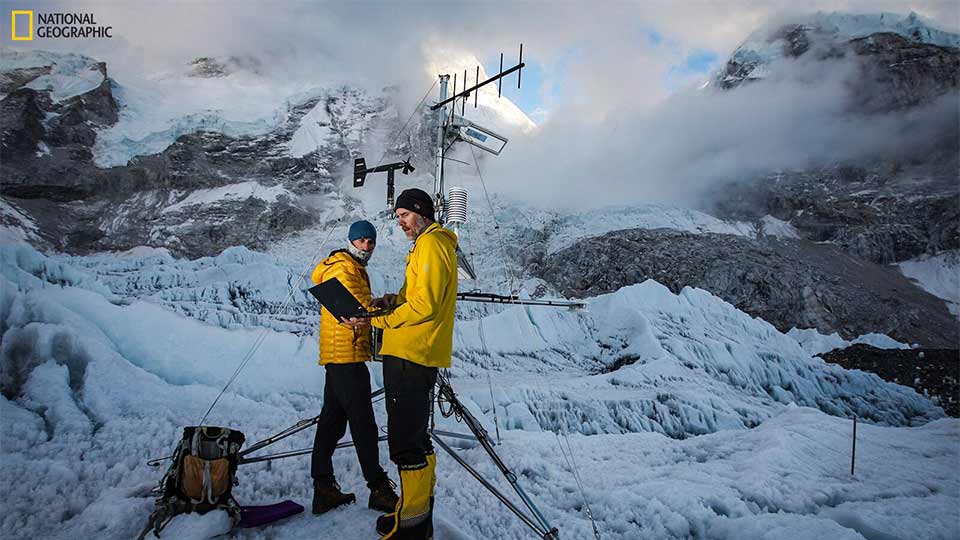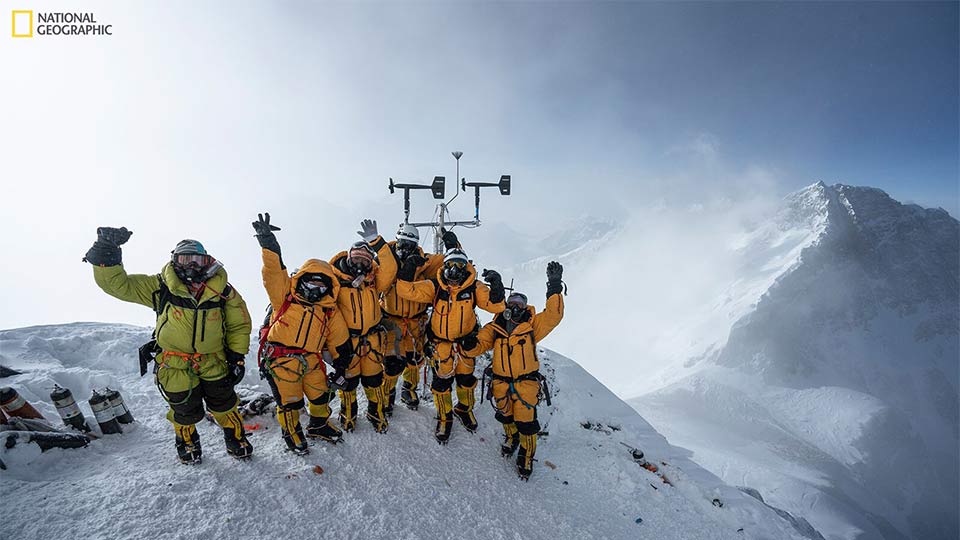
The team celebrates after setting up the world's highest operating automated weather station during National Geographic and
Rolex's 2019 Perpetual Planet Extreme Expedition to Mt. Everest. Photo by Mark Fisher, National Geographic.
A climate scientist from Loughborough University was part of the team that installed the two highest weather stations in the world on Mount Everest to enable communities to respond to climate risks.
Led by the National Geographic Society and Tribhuvan University in partnership with Rolex, Dr Tom Matthews joined a team of international scientists, storytellers, and climbers on a two-month expedition, to research into the effects of climate change on the glaciers and the environment on the mountain.
Two weather stations were installed by Dr Matthews, Dr Baker Parry from Appalachian State University (North Carolina, USA), and a team of Sherpas, and sit at 8,430 meters and 7,945 meters. A further three stations were also installed.
They will provide researchers, climbers and the public, with near real-time information about mountain conditions.
Each station will record data on aspects such as temperature, humidity, wind speed and wind direction.
Previous studies have shown that the glaciers are rapidly disappearing due to increasing global temperatures.
Little is known about future impacts their disappearance could have on the lives and livelihoods of the more than one billion people in the region, who depend on the reliable flow of water the glaciers provide.
As well as installing the weather stations, Dr Matthews will also help to monitor the upper atmosphere, which is critical to tracking and predicting weather patterns around the globe.
The National Geographic Society believes the research is the most comprehensive single scientific expedition to the mountain in history.
Dr Tom Matthews, of the University’s School of Social Sciences, said: “This research is important across a range of scales. Locally, the installed weather stations will enable us to improve weather forecasts on Everest, making the mountain safer for those trying to climb it.
"They also inform understanding of how the jet stream may be changing as the climate warms, and how quickly high-altitude glaciers in the Himalayas (which store water for hundreds of millions of people) may be retreating. These issues are of global significance.”
“We tested the weather stations extensively in Nepal, including practicing to erecting them as quickly and efficiently as possible, at altitude, and with a team of six people.
"We knew that the lack of oxygen and the effects of exhaustion would give us a maximum of two to three hours to get the station up and working before we had to descend.”

Dr. Tom Matthews and Dr. Baker Perry, members of the National Geographic and Rolex Perpetual Planet Extreme Expedition to Mt. Everest, work on the automated weather station at Everest Base Camp. Photo by Freddie Wilkinson, National Geographic.
As well as installing the weather stations, members of the expedition team conducted research in five areas of science that are critical to understanding environmental changes and their impacts. The five areas were: biology, glaciology, meteorology, geology, and mapping.
During the expedition the team also:
- Collected the highest-ever ice core sample (at 8,020 meters)
- Conducted comprehensive biodiversity surveys at multiple elevations
- Completed the highest elevation helicopter-based lidar scan
- Expanded the elevation records for high-dwelling species and documented the history of the mountain’s glaciers.
Jonathan Baillie, executive vice president and chief scientist at the National Geographic Society, said: ”Climate change is one of the biggest challenges facing humanity and there is still much to learn about how it’s already altered the world, from the deepest parts of the ocean to its tallest mountains.
“By harnessing our 131-year history of exploration and venturing into some of the most extreme environments on the planet, we will fill critical data gaps on the world’s life support systems and drive solutions to assure that they can continue to fuel our future.”
More in-depth information about the initial scientific findings and their significance is here
Notes for editors
Press release reference number: 19/85
Loughborough University is equipped with a live in-house broadcast unit via the Globelynx network. To arrange an interview with one of our experts please contact the press office on 01509 223491. Bookings can be made online via www.globelynx.com
Loughborough is one of the country’s leading universities, with an international reputation for research that matters, excellence in teaching, strong links with industry, and unrivalled achievement in sport and its underpinning academic disciplines.
It has been awarded five stars in the independent QS Stars university rating scheme, named the best university in the world for sports-related subjects in the 2019 QS World University Rankings, University of the Year by The Times and Sunday Times University Guide 2019 and top in the country for its student experience in the 2018 THE Student Experience Survey.
Loughborough is in the top 10 of every national league table, being ranked 4th in the Guardian University League Table 2020, 5th in the Times and Sunday Times Good University Guide 2019 and 8th in The UK Complete University Guide 2020.
Loughborough is consistently ranked in the top twenty of UK universities in the Times Higher Education’s ‘table of tables’ and is in the top 10 in England for research intensity. In recognition of its contribution to the sector, Loughborough has been awarded seven Queen's Anniversary Prizes.
The Loughborough University London campus is based on the Queen Elizabeth Olympic Park and offers postgraduate and executive-level education, as well as research and enterprise opportunities. It is home to influential thought leaders, pioneering researchers and creative innovators who provide students with the highest quality of teaching and the very latest in modern thinking.
National Geographic Society
The Everest expedition is part of National Geographic’s newly established Life at the Extremes program and is the first in a series of Perpetual Planet Extreme Expeditions that are supported by a renewed and expanded partnership between National Geographic and Rolex. The expeditions aim to explore and better understand some of the most extreme environments on planet Earth. Data collected from the Perpetual Planet Extreme Expeditions in these environments will support new decision-making tools, called Perpetual Planet Extreme Indices, which will provide real-time and historical data on the factors that contribute to the health of these ecosystems. Additionally, to underscore the urgency of the team’s work, the scientific research conducted by the expedition team will be complemented by coverage in National Geographic’s robust portfolio of media assets, including on NationalGeographic.com and in National Geographic magazine.
Learn more
You can follow updates from the Perpetual Planet Extreme Expedition: Everest and explore historical and new data about the role of Mount Everest as a water tower for the region at www.natgeo.com/everest.
For more on the Life at the Extremes program, you can visit www.natgeo.org/extremes.
Resources
A full fact sheet outlining the scientific goals and accomplishments of the Perpetual Planet Extreme Expedition: Everest is here.
- Meet the expedition team members here.
- More on the partnership between National Geographic and Rolex, here.
- Photo assets for coverage of the expedition are here.

